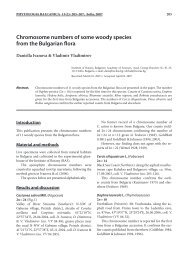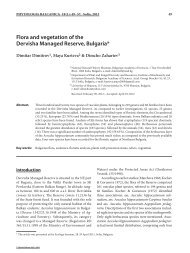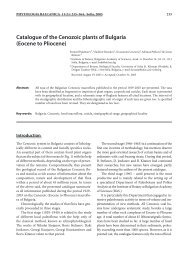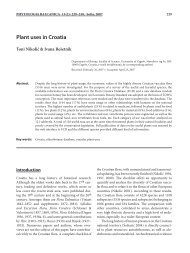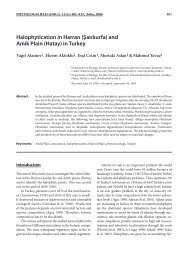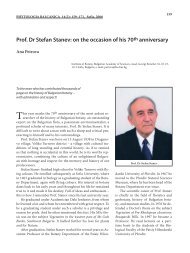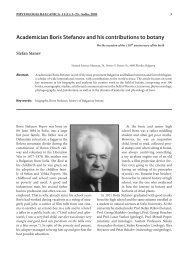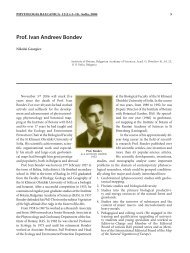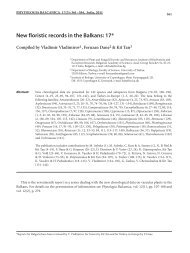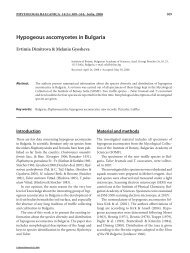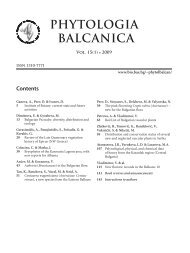Erica multiflora (Ericaceae), Onosma pygmaeum ... - Bio.bas.bg
Erica multiflora (Ericaceae), Onosma pygmaeum ... - Bio.bas.bg
Erica multiflora (Ericaceae), Onosma pygmaeum ... - Bio.bas.bg
You also want an ePaper? Increase the reach of your titles
YUMPU automatically turns print PDFs into web optimized ePapers that Google loves.
PHYTOLOGIA BALCANICA 16 (2): 267 – 269 Sofia, 2010<br />
<strong>Erica</strong> <strong>multiflora</strong> (<strong>Erica</strong>ceae), <strong>Onosma</strong> <strong>pygmaeum</strong> (Boraginaceae)<br />
and Typha minima (Typhaceae) in Albania<br />
Alfred Mullaj 1 & Kit Tan 2<br />
1 Museum of Natural Sciences, Faculty of Natural Sciences, Tirana University, Albania<br />
2 Institute of <strong>Bio</strong>logy, University of Copenhagen, Øster Farimagsgade 2D, DK-1353<br />
Copenhagen K, Denmark, e-mail: kitt@bio.ku.dk (author for correspondence)<br />
Received: June 06, 2010 ▷ Accepted: July 18, 2010<br />
Abstract. <strong>Erica</strong> <strong>multiflora</strong> (<strong>Erica</strong>ceae) in Albania is confirmed to occur in the Karaburun Peninsula as well as other<br />
regions in Albania. This links the distribution of the species in Croatia to that of western Greece. <strong>Onosma</strong><br />
<strong>pygmaeum</strong> (Boraginaceae) and Typha minima (Typhaceae) are reported as new for the Albanian flora. The<br />
former was previously considered endemic to the serpentine areas of N Pindos in NW Greece.<br />
Key words: Albania, distribution, <strong>Erica</strong>, Greece, new records, <strong>Onosma</strong>, serpentine endemic, Typha<br />
<strong>Erica</strong>ceae<br />
<strong>Erica</strong> <strong>multiflora</strong> L. is a common component of macchie<br />
in the western Mediterranean, reaching its easternmost<br />
limits on western mainland Greece. It is an<br />
erect evergreen shrub usually less than 1.5 m tall although<br />
it can reach a height of up to 3 m. However, in<br />
the Mediterranean coastal macchie where it is a dominant<br />
species, shallow soils and low rainfall limit growth.<br />
It flowers once a year, in the autumn, and is observed<br />
capable of re-sprouting after fire. It has some medicinal<br />
uses – extracts of leaves have been used to treat inflammation<br />
and reduce hypertension in N Africa but it<br />
is not listed as a medicinal plant in Albania.<br />
<strong>Erica</strong> <strong>multiflora</strong> is not recorded in Flora Europaea<br />
(Tutin & al. 1972: 7) as occurring in Greece and its<br />
presence in Albania was queried as doubtful (indicated<br />
by ?Al). It is also not mentioned in the relevant volume<br />
of the Albanian Flora (Qosja & Paparisto 1996).<br />
Occurrence in Croatia is however, documented. Its<br />
presence on western mainland Greece and on the Ionian<br />
island of Levkas has recently been confirmed (see<br />
Tan, Kit & al. 2010). Charles Nelson (Heather Society,<br />
U.K.) who is preparing a monograph on <strong>Erica</strong> to be<br />
13 • Phytol. Balcan. 16(2) • 2010<br />
267<br />
published at Kew in 2010 informed one of us (KT) he<br />
has no knowledge of the species’ existence in Albania<br />
and if such information could be provided, it would<br />
link the Croatian and Greek distribution. Thus we decided<br />
to make a search in literature and in the herbarium<br />
at Tirana (TIR) to see if E. <strong>multiflora</strong> has been<br />
documented in any way.<br />
Ilia Mitrushi (1904–1986) an Albanian botanist<br />
previously <strong>bas</strong>ed at Tirana University had made two<br />
publications 44 and 55 years ago. In Trees and shrubs<br />
of Albania (Mitrushi 1955) and Dendroflora of Albania<br />
(Mitrushi 1966), the author provides the distribution<br />
of E. <strong>multiflora</strong> in the Karaburun Peninsula, Vlora<br />
Bay in S Albania. This is a dry, calcareous, rocky<br />
area dominated by low macchie comprising Quercus<br />
ilex, Q. coccifera, Arbutus unedo and Laurus nobilis,<br />
phrygana and small patches of Quercus ithaburensis.<br />
Other species widely distributed in the area are <strong>Erica</strong><br />
manipuliflora, Prasium majus and Galactites tomentosa<br />
(for complete list see following paragraphs).<br />
The Karaburun Peninsula is a typically Mediterranean<br />
coastal area with a mild climate of dry summers, cool<br />
winters, rainy springs and autumns. The annual rainfall<br />
is 1200–1300 mm and the average annual temperature
268 Mullaj, A. & Tan, Kit • New records for the Albanian flora<br />
varies between 15–16 °C. In April 2010 we considered a<br />
visit to the peninsula but were discouraged by the necessity<br />
of obtaining a permit six months in advance as it is<br />
still a protected military zone. However, one of us (AM)<br />
had visited it at least three times in previous years.<br />
The most widespread vegetation on the peninsula<br />
is Phlomis fruticosa phrygana at 0–900 m. The<br />
dry shallow soil overlying limestone rock is poor and<br />
stony. Anthyllis hermanniae, Asparagus acutifolius, Asphodelus<br />
microcarpus, Calicotome villosa, Chrysopogon<br />
gryllus, <strong>Erica</strong> manipuliflora, Galactities tomentosa, Paliurus<br />
spina-christi, Pistacia lentiscus, Pyrus amygdaliformis,<br />
Quercus coccifera, Rhamnus alaternus, Rubia<br />
peregrina, Smilax aspera, Thymus capitatus, Urginea<br />
maritima are amongst the species noted.<br />
Extensive areas on the peninsula are covered<br />
with macchie and Mediterranean evergreen forest at<br />
0–800 m. The larger valleys (stream courses) from the<br />
foothills to summits are bordered by Acer campestre,<br />
Fraxinus ornus, Olea europaea subsp. sylvestris, Phillyrea<br />
angustifolia, Pistacia lentiscus, Quercus coccifera<br />
and Q. ilex. These forests are very rare in Albania<br />
but they are well preserved in the Karaburun Peninsula<br />
because the region has for a long time been a military<br />
zone. The main plant communities of macchie<br />
are those dominated by Quercus coccifera and those<br />
dominated by Arbutus unedo and <strong>Erica</strong> arborea. The<br />
shrub and herb layer of these plant communities include<br />
Carpinus orientalis, Cotinus coggygria, Laurus<br />
nobilis, Myrtus communis, Prasium majus and Rhamnus<br />
alaternus.<br />
The dominant oak within the evergreen forest below<br />
800 m is Quercus ithaburensis subsp. macrolepis<br />
(the Valona oak). It occurs in small patches without<br />
forming a distinct forest belt. Mediterranean species<br />
in the undergrowth include Acanthus spinosus, Cercis<br />
siliquastrum, Cistus salvifolius, Galium aparine, Hypericum<br />
empetrifolium, Satureja montana, Securigera<br />
securidaca and Trifolium stellatum.<br />
Since January 2010 the herbarium at the Department<br />
of <strong>Bio</strong>logy, Tirana University is slowly shifting<br />
over to the Museum of Natural Sciences (TIR) so<br />
the latter is still not completely accessible for consultation.<br />
According to AM, the <strong>Erica</strong> material collected<br />
by Mitrushi from 1956 to 1961 is deposited in TIR.<br />
There is also material collected after 1961 which has<br />
been erroneously identified as E. manipuliflora Salisb.<br />
Both species are autumn-flowering but E. <strong>multiflora</strong><br />
can be readily distinguished by its larger flowers (co-<br />
rolla 4–7.5 mm not 3–3.5 mm) and longer anthers<br />
(ca. 1.5 mm not 0.7–1 mm).<br />
The following specimens (flowering material) have<br />
been examined by AM in the herbarium of the Museum<br />
of Natural Sciences (TIR). They verify the statements<br />
of Mitrushi (1955, 1966) and confirm the presence<br />
of the species in Albania.<br />
Tirana district: Mt Brari, 350 m, calcareous ground,<br />
15 October 1956, Qosja, Balza & Mitrushi.<br />
Lushnja district: Divjaka forest, 5 m, sand dunes,<br />
07 October 1960, Demiri, Palikuqi & Mitrushi.<br />
Vlora district: Llogora gorge, 450 m, calcareous<br />
ground, 07 September 1961, Mitrushi; Dhermi village,<br />
250 m, calcareous ground, 26 August 1958, Mitrushi &<br />
Duka; loc. ibid., 250 m, calcareous ground, 28 August<br />
1959, Lako & Mitrushi.<br />
Given this wealth of herbarium evidence it would<br />
seem that when the account of <strong>Erica</strong>ceae was prepared<br />
for the Flora of Albania, the editors may not have consulted<br />
the herbarium but had followed Flora Europaea.<br />
They had extracted and compiled accounts only<br />
for those taxa listed in the Flora Europaea volumes as<br />
present for Albania.<br />
Boraginaceae<br />
<strong>Onosma</strong> <strong>pygmaeum</strong> Riedl (Figs. 1 & 2).<br />
S Albania. Gramshi district: Dushku lake, serpentine<br />
rocks, 1200–1300 m, 20 May 2010, Mullaj & Shehu<br />
(TIR, herb. Kit).<br />
Korca district: near Boboshtica village, serpentine<br />
rock, 30 June 2010, Shuka (photo!).<br />
This species is a low cushion-like perennial first described<br />
from the Katara Pass in N Pindos and was pre-<br />
Fig. 1. <strong>Onosma</strong> <strong>pygmaeum</strong> at<br />
Dushku lake (photo L. Shuka).<br />
Fig. 2. <strong>Onosma</strong> <strong>pygmaeum</strong> from<br />
Korca district (photo L. Shuka).
Phytol. Balcan. 16(2) • Sofia • 2010<br />
viously considered a serpentine endemic restricted to N<br />
Pindos in NW Greece. Its presence on serpentine in S Albania<br />
is not surprising. As our investigations on the border<br />
area between Greece and Albania continue we have<br />
lost quite a few “Greek endemics” with the noted extension<br />
of their distribution ranges in Albania. <strong>Onosma</strong> <strong>pygmaeum</strong><br />
is now recorded as a Balkan endemic new for<br />
the Albanian flora. Other Greek endemics which have<br />
changed their status recently include Cerastium smolikanum<br />
Hartvig (previously considered endemic to Mt Smolikas)<br />
and Centaurea vlachorum Hartvig (considered endemic<br />
to Mt Milea and Mt Aftia). Both of these are from<br />
N Pindos, NW Greece and restricted to serpentine.<br />
Fig. 3. Typha minima in marsh at Devolli river (photo A. Mullaj).<br />
Acknowledgements. The first author (AM) thanks J. Shehu for<br />
accompanying him in the field during May 2010 and L. Shuka for<br />
the provision of Figs. 1 & 2.<br />
References<br />
Mitrushi, I. 1955. Trees and shrubs of Albania. Tirana (in Albanian).<br />
Mitrushi, I. 1966. Dendroflora of Albania. Tirana (in Albanian).<br />
Typhaceae<br />
269<br />
Typha minima Funck ex Hoppe<br />
S Albania. Gramshi district: marsh at Devolli river,<br />
near Bersnik village along road from Gramsh to Korce,<br />
350 m, 21 May 2010, Mullaj & Shehu (TIR).<br />
The species grows to a height of less than 70 cm which<br />
is a low stature compared to other species of Typha such<br />
as T. latifolia and T. angustifolia. The edge of the marsh at<br />
the Devolli river is rapidly colonized by dense stands of<br />
the plant to the near exclusion of other species (Fig. 3). It<br />
is reported as new for the Albanian flora.<br />
Qosja, X. & Paparisto, K. (eds). 1996. Flora of Albania. Vol. 3.<br />
Acad. Sci. Albania, Tirana (in Albanian).<br />
Tan, Kit, Bonetti, A. & Lafranchis, T. 2010. Reports 74-82. – In:<br />
Vladimirov. V. & al. (comp.), New floristic records in the Balkans:<br />
13. – Phytol. Balcan., 16(1): 143-165.<br />
Tutin, T.G., Heywood, V.H., Burges, N.A., Moore, D.M., Valenti<br />
ne, D.H., Walters, S.M. & Webb, D.A. (eds). 1972. Flora<br />
Europaea. Vol. 3. Cambridge Univ. Press, Cambridge.



